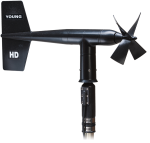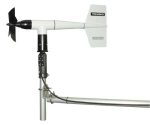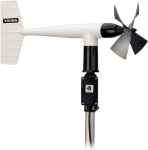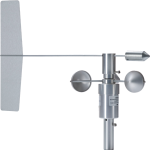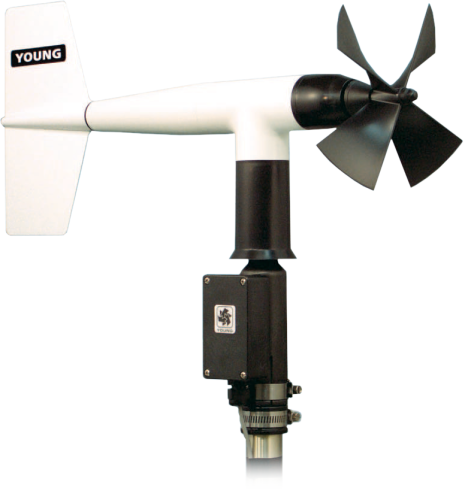
Kompatibel mit fast allen Campbell Scientific Datenloggern






Überblick
Der 05103 Windmonitor ist ein leichtes, robustes Instrument zur Messung von Windgeschwindigkeit und -richtung auch in rauer Umgebung. Seine einfacher und korrosionsbeständer Aufbau macht ihn ideal für zahlreiche Anwendungen. Er wird von RM young hergestellt. Wenn Sie den Windmonitor bei Campbell bestellen, ist er zum Anschluss an unsere Logger verkabelt.
Standardkabellänge ist 3m, andere Kabllängen auf Anfrage. Das Kabel sollte allerdings nicht länder als 300m sein.
Lesen Sie mehrFunktionen und Vorteile
- Rugged enough for harsh environments
- Compatible with the CWS900-series interfaces, allowing it to be used in a wireless sensor network
- Constructed with thermoplastic material that resists corrosion from sea-air environments and atmospheric pollutants
- Uses stainless-steel, precision-grade ball bearings for the propeller shaft and vertical shaft bearings
- Ideal for wind profile studies
- Compatible with the LLAC4 4-channel Low-Level AC-Conversion Module, which increases the number of anemometers one data logger can measure
Bilder



Zugehörige Produkte
Technische Beschreibung
The 05103 Wind Monitor is made out of rigid UV-stabilized thermoplastic with stainless steel and anodized aluminum fittings. The thermoplastic material resists corrosion from sea air environments and atmospheric pollutants. It uses stainless-steel precision-grade ball bearings for the propeller shaft and vertical shaft bearings.
The 05103 measures wind speed with a helicoid-shaped, four-blade propeller. Rotation of the propeller produces an ac sine wave that has a frequency directly proportional to wind speed. The ac signal is induced in a transducer coil by a six-pole magnet mounted on the propeller shaft. The coil resides on the non-rotating central portion of the main mounting assembly, eliminating the need for slip rings and brushes.
Wind direction is sensed by the orientation of the fuselage-shaped sensor body, which is connected to an internal potentiometer. The datalogger applies a known precision excitation voltage to the potentiometer element. The output is an analog voltage signal directly proportional to the azimuth angle.
Kompatibel mit
Mounting
The 05103 can be attached to a CM202, CM202SS, CM203, CM204, CM204SS, or CM206 crossarm via a 17953 Nu-Rail fitting or CM220 Right-Angle Mounting Kit. Alternatively, the 05103 can be attached to the top of our stainless-steel tripods via the CM216 Sensor Mounting Kit. Please note that a lightning rod cannot be used when the CM216 attaches a 05103 atop the tripod’s mast. Therefore the CM216 is only recommended for mounting these sensors if the deployment is short term.
Wind Profile Studies
Wind profile studies measure many wind sensors. For these applications, the LLAC4 4-Channel Low Level AC Conversion Module can be used to increase the number of Wind Monitors measured by one data logger. The LLAC4 allows data logger control ports to read the wind speed sensor’s ac signals instead of using pulse channels. Data loggers compatible with the LLAC4 are the CR200(X) series (ac signal ≤1 kHz only), CR800, CR850, CR1000, CR3000, and CR5000.
Data Logger Considerations
The 05103's propeller uses one pulse count channel on the data logger. Its wind vane requires one single-ended channel and access to an excitation channel (the excitation channel can be shared with other high impedance sensors).
Programming
The 05103's propeller is measured by the PulseCount Instruction in CRBasic and by Instruction 3 (Pulse Count) in Edlog. The wind vane is measured by the BrHalf Instruction in CRBasic and by Instruction 4 (Excite-Delay-SE) in Edlog. The measurements are typically processed for output with the Wind Vector instruction (not present in the CR500 or CR9000 but is present in the CR9000X).
Spezifikationen
| Applications | Harsh (Rain with light snow. Little or no riming. Some blowing sand. No salt spray.) |
| Sensor | Helicoid-shaped, 4-blade propeller and fuselage-shaped sensor body |
| Measurement Description | Wind speed and direction |
| Operating Temperature Range | -50° to +50°C (assuming non-riming conditions) |
| Mounting Pipe Description |
|
| Compliance with Standards |
|
| Housing Diameter | 5 cm (2.0 in.) |
| Propeller Diameter | 18 cm (7.1 in.) |
| Height | 37 cm (14.6 in.) |
| Length | 55 cm (21.7 in.) |
| Weight | 1.5 kg (3.2 lb) |
Wind Speed |
|
| Range | 0 to 100 m/s (0 to 224 mph) |
| Accuracy | ±0.3 m/s (±0.6 mph) or 1% of reading |
| Starting Threshold | 1.0 m/s (2.2 mph) |
| Distance Constant | 2.7 m (8.9 ft) 63% recovery |
| Output |
ac voltage (three pulses per revolution) 90 Hz (1800 rpm) = 8.8 m/s (19.7 mph) |
| Resolution | (0.0980 m s-1) / (scan rate in seconds) or (0.2192 mph) / (scan rate in seconds) |
Wind Direction |
|
| Mechanical Range | 0 to 360° |
| Electrical Range | 355° (5° open) |
| Accuracy | ±3° |
| Starting Threshold | 1.1 m/s (2.4 mph) at 10° displacement |
| Distance Constant | 1.3 m (4.3 ft) 50% recovery |
| Damping Ratio | 0.3 |
| Damped Natural Wavelength | 7.4 m (24.3 ft) |
| Undamped Natural Wavelength | 7.2 m (23.6 ft) |
| Output |
|
| Voltage | Power switched excitation voltage supplied by data logger |
Dokumente
Broschüren Produkte
Realisierte Projekte
Videos & Tutorials
FAQs für
Number of FAQs related to 05103: 13
Alle anzeigenWenige anzeigen
-
This depends on what is broken. Typically, Campbell Scientific can repair the unit, and the user does not have to purchase a new one.
-
The measurement instructions will likely remain the same. However, in addition to the multiplier and offset, the type of pulse may change for the wind speed, and the excitation voltage may change for the wind direction. For an explanation of how the datalogger needs to be programmed, see the instruction manual.
-
Yes, but this is not a standard product that Campbell Scientific offers. We can, however, order one from the manufacturer (R. M. Young).
-
The short answer is less than 0.01 mA. The wind speed signal requires no power. The wind direction portion of the sensor only uses a maximum of 0.5 mA when excited with 5 Vdc, and then it is only on for 0.016 s for every measurement. When the wind direction is measured every second (typical), the average current drain is less than 0.01 mA.
-
Orientation of the wind monitor is done after the datalogger has been programmed, and the location of True North has been determined. True North is usually found by reading a magnetic compass and applying the correction for magnetic declination, where magnetic declination is the number of degrees between True North and Magnetic North. Magnetic declination for a specific site can be obtained from a USFA map, local airport, or through a computer service.
-
- Using Short Cut, click the applicable wind direction sensor in the Selected Sensors list of the Outputs screen.
- The two output options enabled are Sample and WindVector. Select WindVector.
- The WindVector instruction has output options. Select an option with mean wind direction in it.
-
Most Campbell Scientific sensors are available as an –L, which indicates a user-specified cable length. If a sensor is listed as an –LX model (where “X” is some other character), that sensor’s cable has a user-specified length, but it terminates with a specific connector for a unique system:
- An –LC model has a user-specified cable length for connection to an ET107, CS110, or retired Metdata1.
- An –LQ model has a user-specified cable length for connection to a RAWS-P weather station.
If a sensor does not have an –L or other –LX designation after the main model number, the sensor has a set cable length. The cable length is listed at the end of the Description field in the product’s Ordering information. For example, the 034B-ET model has a description of “Met One Wind Set for ET Station, 67 inch Cable.” Products with a set cable length terminate, as a default, with pigtails.
If a cable terminates with a special connector for a unique system, the end of the model number designates which system. For example, the 034B-ET model designates the sensor as a 034B for an ET107 system.
- –ET models terminate with the connector for an ET107 weather station.
- –ETM models terminate with the connector for an ET107 weather station, but they also include a special system mounting, which is often convenient when purchasing a replacement part.
- –QD models terminate with the connector for a RAWS-F Quick Deployment Station.
- –PW models terminate with the connector for a PWENC or pre-wired system.
-
Not every sensor has different cable termination options. The options available for a particular sensor can be checked by looking in two places in the Ordering information area of the sensor product page:
- Model number
- Cable Termination Options list
If a sensor is offered in an –ET, –ETM, –LC, –LQ, or –QD version, that option’s availability is reflected in the sensor model number. For example, the 034B is offered as the 034B-ET, 034B-ETM, 034B-LC, 034B-LQ, and 034B-QD.
All of the other cable termination options, if available, are listed on the Ordering information area of the sensor product page under “Cable Termination Options.” For example, the 034B-L Wind Set is offered with the –CWS, –PT, and –PW options, as shown in the Ordering information area of the 034B-L product page.
Note: As newer products are added to our inventory, typically, we will list multiple cable termination options under a single sensor model rather than creating multiple model numbers. For example, the HC2S3-L has a –C cable termination option for connecting it to a CS110 instead of offering an HC2S3-LC model.
Anwendungsbeispiele
Overview As part of the United Nations Development Programme's (UNDP) Climate Adaptation Water and Energy Programme......lesen Sie mehr
Historically, the South African energy sector had been monopolized by a single state-owned utility company......lesen Sie mehr
In 1922, when the intact tomb of Tutankhamen was discovered in Egypt's Valley of the......lesen Sie mehr
The West Texas Mesonet (WTM) project was initiated by Texas Tech University in 1999 to......lesen Sie mehr
